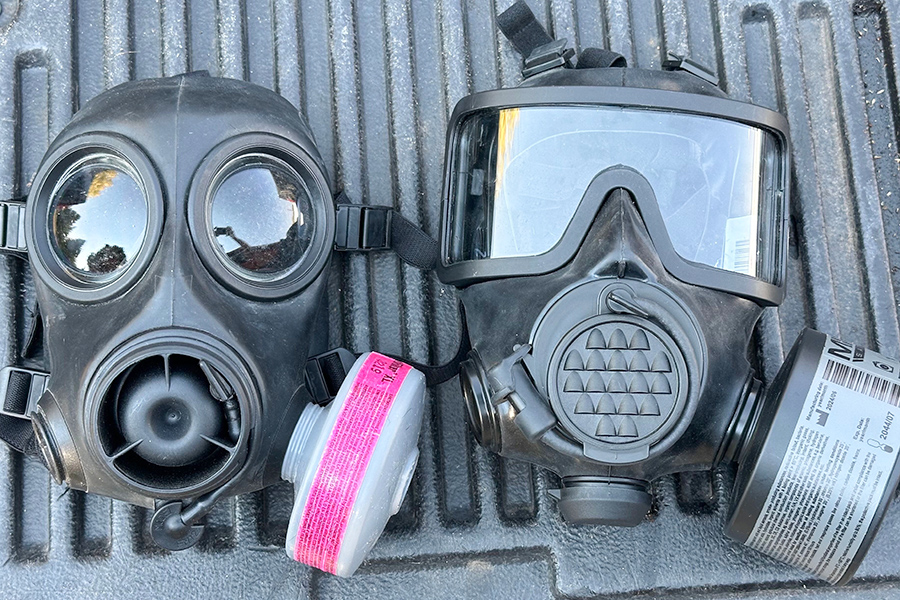
The moment the German Army unleashed chlorine gas and then sulfur mustard gas on the battlefield during World War I, the arms race between delivering chemical weapons and protecting troops from them was on. Despite the fact that numerous treaties and conventions prohibited or restricted the use of chemical weapons, every member of the United States military has been trained in CBRN or NBC warfare protection for approximately 100 years or so.
As the progression always goes; the military experiments and does it first, then law enforcement does it, and then finally it crosses over to the world of the citizen. Consider the use of modern, ready-made tourniquets; US Military trials and use, then police training and use, and now civilian training and use.
On a smaller, but growing scale, we are seeing that same phenomenon with field protective masks or, more as they’re more commonly called, “gas masks.” The US military has a century of experience with masks. During the riots of the 1960’s and 70’s, the use of CS and CN gas by American law enforcement became prevalent, though it had been used prior to that. Riot police understood that gas is an equal opportunity agent and it can blow back onto those who deployed it. Therefore, all the SWAT teams and riot squads were trained to use gas masks.
Personally, like hundreds of thousands of veterans, I first learned how to use a gas mask in Boot Camp and discovered that it really worked when we entered the “gas chamber.” As an infantry Marine, I engaged in constant training with masks and other protective gear. During Operation Desert Storm, my unit went into combat with our protective suits and boots on. A few hours later, we went to MOPP-4 and put on our masks and gloves. That was interesting. Additionally, I also went through “crowd control” training in the Police Academy a few years later.
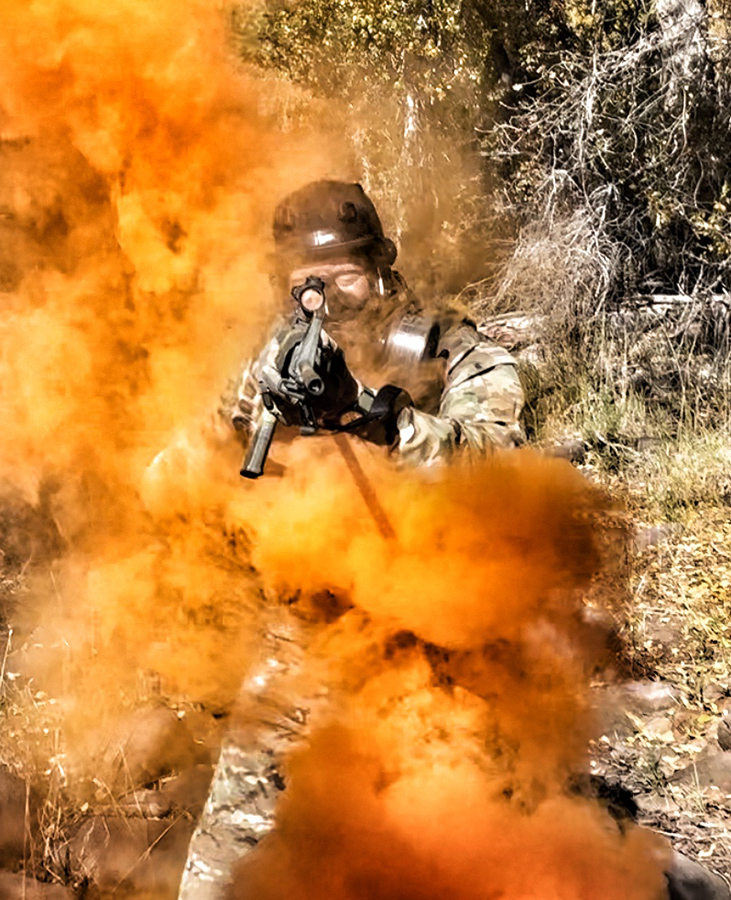
Now, thanks to the good old American free market, there are companies producing and advertising field protective / gas masks to the citizens of the United States. Mira Safety is one of the biggest. Yes, there have been military surplus masks for sale for decades, but those were marketed to a niche audience. Today, gas masks are going “mainstream” on social media.
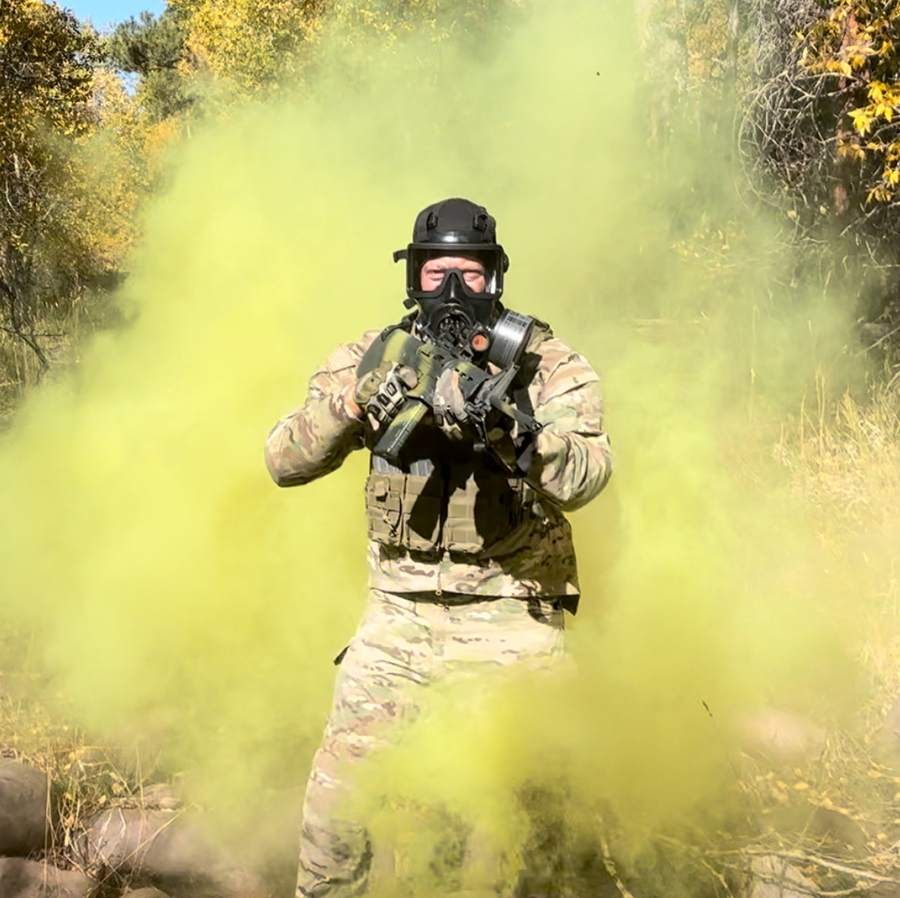
Do Not Buy a Gas Mask Until Your Read This
If you have already purchased some type of gas mask, I will address you later. However, if you are thinking about buying one or more, please read this article before you spend your money.
Consideration #1, you need to have an honest conversation with yourself. Are you willing to actually put the mask on, fit it properly to your melon, learn how to test the seal, and wear it during training? If your honest answer is “no”, then do not waste your money buying a gas mask.
I fear that too many people are buying gas masks “just in case” and then sticking them on a shelf somewhere never to be thought of again. The middle of a crisis is NOT the time to try and learn how to use a field protective mask. In the Marine Corps that standard to “don and clear” a gas mask with hood was 10 seconds.
Consideration #2, who gets to breathe? What? What are you talking about? Well, if you are the patriarch of the family, the defender of the sheep, and buy one mask for yourself, what do the rest of the members of your family do during a genuine emergency? Four people sharing one mask is not a good plan. Unless your mask is part of a proactive tool kit, you need to factor in purchasing one for each person in the house and teaching them how to use them.
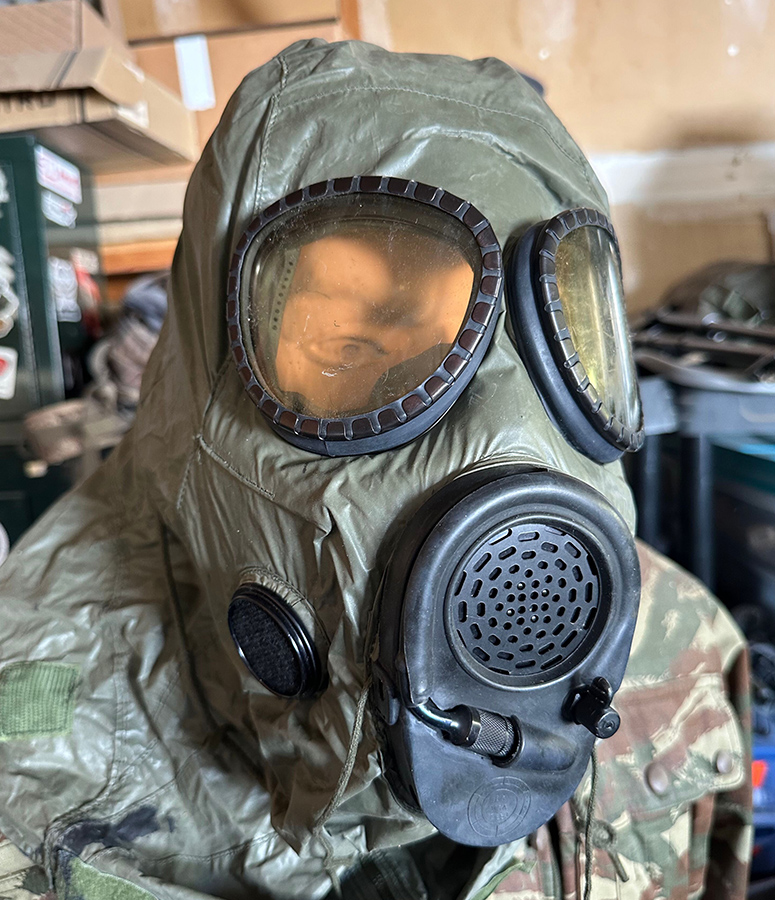
Consideration #3, if you are buying a surplus/old gas mask, what condition is it in? The head harnesses are made of nylon and elastic and these break down and fail over time. If the harness won’t keep the mask tight against your face, it is useless. Masks are made of rubber and the enemy of rubber is direct sunlight and extreme temperatures. Military masks are extremely durable, however, a surplus mask could have been sitting on a shelf or in a crate for decades baking in the heat or freezing in a warehouse or Conex box. Let the buyer beware!
Consideration #4, do you have a big head? If you were blessed by the Lord with a gargantuan cranium, the average mask may not fit your noggin. Before you order, check to see if the gas masks come in different sizes. If they only come in one size, chances are very high that that size is a medium or average. Brothers, if your Stetson is sized 7 ¾, you are going to need a size “Large” gas mask.
Choosing a Field Protective Mask
There are two basic styles of gas mask; full face shield and goggle type. The full face shield has a single window with no obstructions in the field of view. The goggle type has two separate eye holes or lenses. The size and shape of these viewing holes will vary based upon the manufacturer. Some are round and some are three-sided ovals.
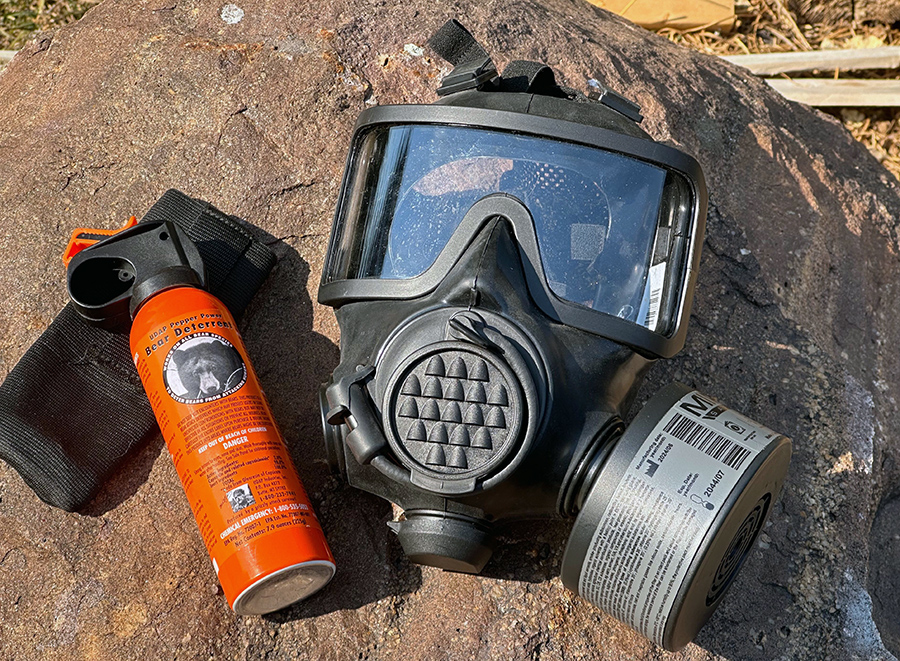
As for pros and cons, the full face shield type does not fold for easy storage in a pouch and may be more prone to damage in a field environment. However, the feeling of claustrophobia that you get from wearing a mask is greatly reduced with a full face shield and your field of vision for shooting, etc. is much better.
Dual lens versions tend to be the choice of military units. They do have that dead zone or blind spot right in the middle that you only seem to notice when you are trying to shoot your rifle or pistol.

Today, the standard for Military and LE masks are those which use a 40mm screw-in filter. There are myriad types of filters from those designed to keep out dust all the way up to those which will filter radioactive fallout. Unlike the old-style masks where the filter screwed in the middle, modern masks allow the user to choose a side. PS: the filter goes on the opposite side of your rifle shoulder.
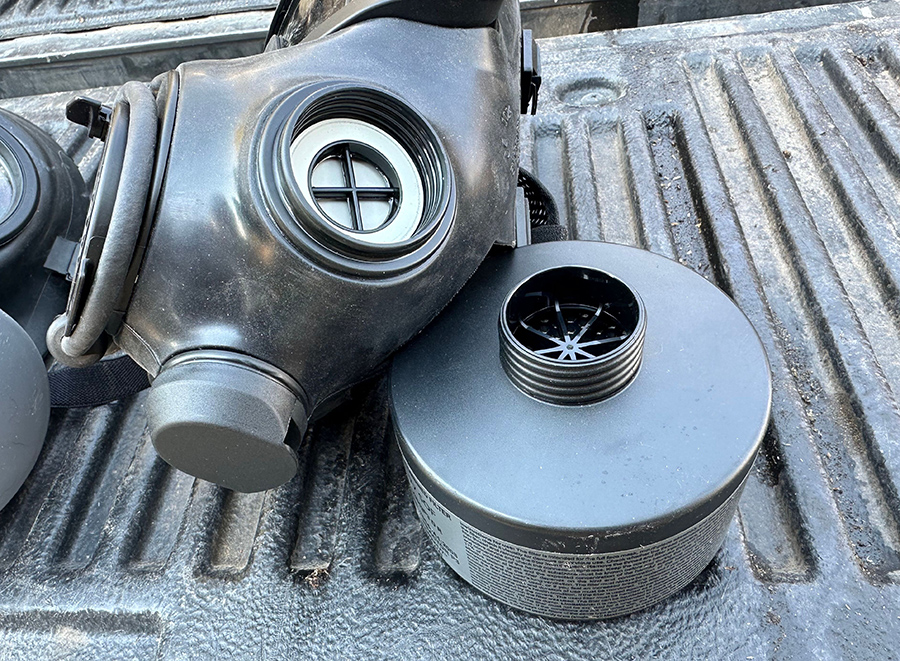
Threats
You are an adult, you can read the news. Over 17,000 Georgia residents were evacuated after a chemical plant caught fire and spewed toxic smoke into the atmosphere and 90,000 residents were told to shelter in their houses and not go outside. The East Palestine train derailment and then subsequent chemical fire, set deliberately, poured toxic smoke into the air, the damage of which we will not likely know for decades.
When I went through the Police Academy we had a HAZMAT class. Our instructor brought up something that most of us had never considered. He stated, “If your town has railroad tracks running through it, there are toxic and deadly chemicals passing by daily or weekly, but regularly. If your city has a railroad depot, there are containers of toxic chemicals sitting there. All it takes is a derailment or leak to cause a major disaster.”
As I mentioned, you are all adults, you can make your own decisions regarding whether you think owning a gas mask makes you prepared or paranoid. Regardless, you should make an informed decision.
Paul G. Markel is a combat decorated United States Marine veteran. He is also the founder of Student the Gun University and has been teaching Small Arms & Tactics to military personnel, police officers, and citizens for over three decades.

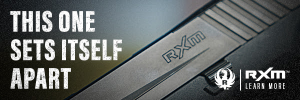
Point of curiosity: short of a complete hood / suit, are there any gas masks that work if you have a full beard?
I know that I can’t get a good seal with your typical respirator, and have been told that the only real option is either a suit or a positive pressure setup (which for the tasks I’m wanting PPE for would be overkill).
I suspect not.
A place I worked had some job slots that required gas masks as part of ppe. There was a grooming requirement – no beard, no mustache, no sideburns. If you didn’t shave that morning, you were sent home without pay for the day. I doubt the union would have stood for that if the company could have bought equipment that would work with stubble or beards.
“Point of curiosity: short of a complete hood / suit, are there any gas masks that work if you have a full beard? ”
Nope. Zero.
A gas mask depends on a good seal. Full (or bushy) beard hair ‘compacts/mats’ under the mask material and prevents a good seal. There is a claim that using a very liberal application of Vaseline on the full (or bushy) beard then donning the mask will ensure a good seal, however, in testing this has been proven to be fallacy for a number of reasons. The idea with the Vaseline means you slather on gobs of the stuff, and that will contact the mask and being mushed into the beard would, basically, fill any gaps for air ingress through any gaps left by the matted beard hair slightly lifting the mask area away from the face. Sounds good in concept, and does work to an extent but think about what Vaseline does when exposed to body heat – that’s right, it ‘breaks’ down by thinning out and tends to be absorbed by hair and skin and tends to smooth out meaning that ‘globs of Vaseline’ seal assistance is not going to last long at all, plus, when you start moving around or talking the mask is going to ‘slip’ around in that ‘globs of Vaseline’ area and may (probably will) open up a gap. The next problem with the Vaseline method is time – do ya have time to apply all the Vaseline needed if ya only have maybe several seconds before the mask is needed? There are a lot more issues with the Vaseline method.
Face it LKB, a mask was not intended to be used on your full beard.
On the subject of “hood / suit”, if you mean a setup like the (CBRN type) military uses, it too depends on a good seal with the mask. If the mask portion doesn’t seal properly, the hood/ suit will keep the ‘agent’ from touching your skin but with no proper seal on the mask you are going to be inhaling the ‘agent’ in a gas/fine-aerosol form and maybe in some cases in liquid form.
But take heart, for full bearded (who will not shave the beard off) people there are two options: 1- escape hoods – these (depending on what you get) are good for on average 15 minutes and would seal around the neck below the chin under the beard. But the down side is they are geared towards toxic industrial and/or fire-related gases, vapors and particles and not things like exposure to chemical agent gases (although for some there may be some very short term limited protection such as from tear gas type agents). Escape hoods are generally ‘fragile’ and prone to fogging up excessively 2- the positive pressure mask – Similar to escape hoods but more effective. Testing has shown that beards do little to interfere with the face seal letting external air in because any gap is compensated for with positive air pressure forcing air out. A positive pressure system, like a PAPR or SCBA, is much more expensive than conventional masks though. Or you could go full level 4 ‘bio-hazard’ suit with self contained air supply or integrated filtering and integrated mask, you step into it and seal it up and ready to go and don’t need to worry about donning a mask.
Or, ya could take a few minutes right when you need a mask to shave the beard off but that’s probably not going to work out too well.
Thanks y’all, that confirms my understanding.
I’d read that some bearded people have tried using a neoprene diver’s hood so that the gasket of the respirator/gas mask seals against the hood, and the hood seals around the neck, but even if that worked reliably I suspect it would be stupid hot (try wearing a wetsuit out of water for more than a few minutes!), especially outdoors in a warm climate.
Looks like what I need is to find an “escape hood” respirator for when I need vapor/gas PPE for various projects (e.g., using concentrated ammonia to fume oak), or bite the bullet on a PAPR respirator (e.g., 3M Powerflow or clone thereof).
The neoprene diver’s hood in concept sounds like a good idea but in practical use its not really such a good idea. The problem is the material and although a synthetic rubber it does not have all the qualities of actual rubber, it may be water proof but its not really chemical or chemical agent proof so, for example, a chemical agent in liquid form (or a ‘gas’/fog that will condense on surfaces) can actually permeate the neoprene along its sub surface (just below the material surface) leading to ‘leaks’ (by capillary action) into the face area under the mask even though the mask seems sealed against the neoprene. If you are going to be protecting against ‘fogging’ (which is really an aerosol form) types of ‘chemical’ agents (e.g. high density tear gas, or more insidious nerve/blister/choking and biological agents), or chemical spill type gasses, especially longer term exposure, you do not want to use the neoprene diver’s hood method.
Good points, but to me the idea of wearing a neoprene hood on my head in the Texas heat is enough to make that a nonstarter.
Someone else suggested that there is way to retrofit a full face negative pressure respirator, so that instead of screwing a filter cartridge onto the mask, you screw on a hose that runs to a belt mounted PAPR pump (to which you attach the filter cartridge), turning it into a positive pressure system. Additional benefit is that because you’re getting a constant flow of forced filtered air, it’s cooler and the mask doesn’t fog as easily.
I see that surplus battery powered, belt mounted PAPR pumps can be had on eBay for under $100. As I already have a full face respirator, that might be a solution (for PPE, not for combat).
OH heck yeah… a neoprene diver’s hood would be hot too. Winter time, maybe not so much but warm weather heck yeah its going to get hot.
“Point of curiosity: short of a complete hood / suit, are there any gas masks that work if you have a full beard? ”
Not really, your best bet would be an SCBA pack, like what firemen wear, a pony bottle of breathable air/oxygen and a full face mask that stays at a positive pressure from the gas bottle, so a perfect seal isn’t required.
That gives you 20-30 min to escape wherever you are at.
Do you really foresee such a need in central Texas, where yo can shoot back???
You can get a PAPR (powered air-purifying respirator) that relies on positive air pressure instead of a tight seal. They have a variety of cartridges, and are very easy to breathe in. They are very expensive, and require batteries with chargers, however, so keep that in mind.
Not that I’ve been able to find. When OSHA changed the silica dust standards we had to start wearing masks for some tasks at work. Our contract did not allow them to force us to shave so they got 3M PAPRs for some of us. You can find them on Amazon for about a grand (or more). They are just N100 HEPA filters though so won’t work against CS gas but someone probably makes ones that take standard filters.
Stay away from old Warsaw Pact filters. Asbestos was the rage for them.
“Stay away from old Warsaw Pact filters.”
I’ve seen a couple of ‘Urban Explorer’ YouTube videos with titles like “We found a cold-war bunker with EVERYTHING inside!”
…only to discover once I watched them to be thoroughly looted except for one item – Those Warsaw-pact gas masks in large heaps….
….
One thing to keep in mind – a “gas mask” is designed to protect against chemical and biological agents, along with hazardous particles like from a radiological “dirty” bomb.
Against a HAZMAT spill, it may or may not work. For HAZMAT preparedness, you can get a respirator that will provide solid protection. Broad spectrum cartridges are pricier, but they are likely cheaper than a gas mask. I’m a big fan of 3M’s respirators. (one plus side – you can use the same mask with cheaper OV/P100 cartridges for spray-painting or other work with lots of solvent vapors.) If you get one, make sure it fits well and seals to your face. If you cover the exhalation valve and exhale, the respirator should puff out, if you inhale while covering the cartridge inlets, the mask should be pulled in by the suction. While wearing the mask & cartridges, you should not be able to smell air freshener sprayed outside of the mask.
Since people already covered beards, I’ll mention eyeglasses. You need a special glasses kit to wear glasses under a mask, otherwise the side legs / temples will break the seal
While in the army I was at a weapons site and were required to test our mask seals with banana oil. It seemed to be the standard fielf test at the time, circa 1979-1982.
Old Timer
I am going to report this article to the Guinness Book and alert them to a contender for “biggest understatements in human history.” The statement about the difficulty and annoyance inherent in filter replacement on the M17 gas mask is surely bigger than the famous announcement made by the pilot of Speedbird 009.
(signed)
A veteran of a semi-successful pre-Gulf War attempt to change the filters on an M17 gas mask